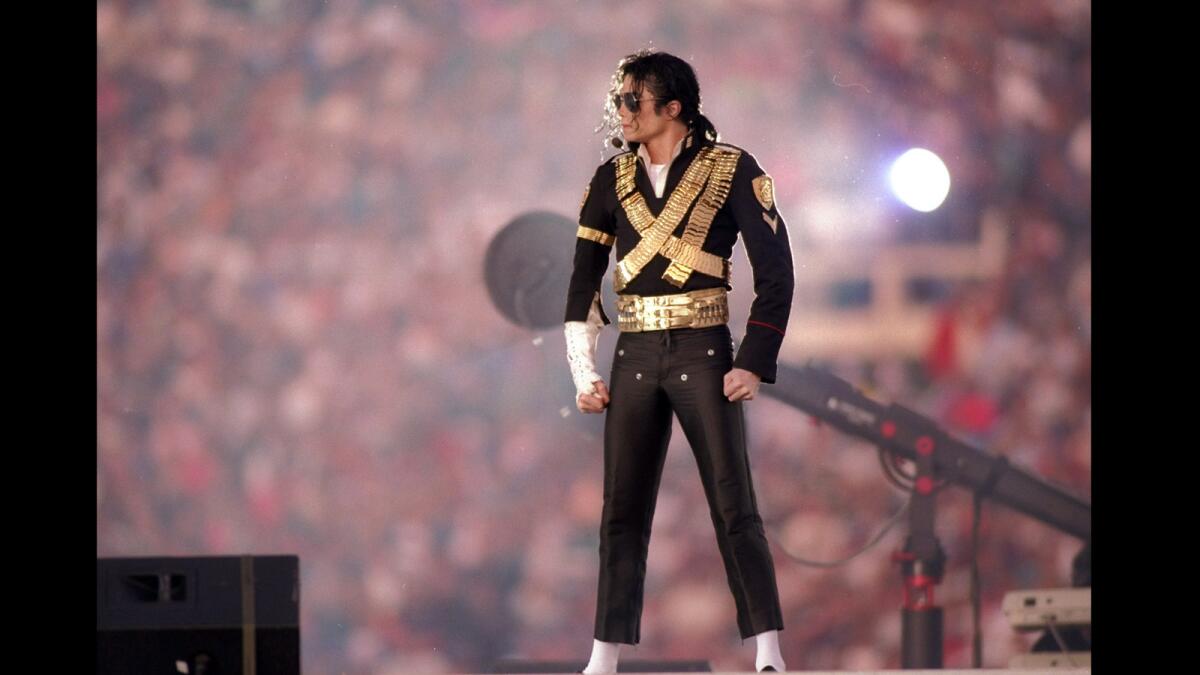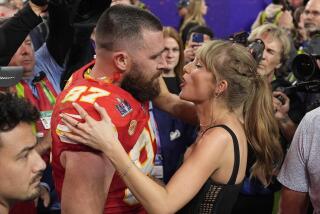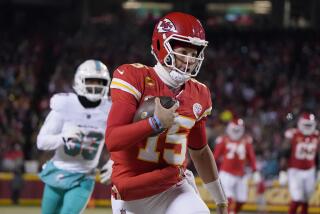Super Bowl wasn’t always the audience magnet it is now

Michael Jackson performs in 1993 during halftime at Super Bowl XXVII between the Dallas Cowboys and the Buffalo Bills at the Rose Bowl in Pasadena.
NBC sports executive Dick Ebersol was unhappy about the matchup for Super Bowl XLIII in 2009.
The Pittsburgh Steelers were always a desirable draw. But the Arizona Cardinals? The franchise had a long history of futility in the NFL, and some embarrassing losses in the regular season.
Veteran sportscaster Al Michaels said he tried to allay Ebersol’s concerns of a ratings dive: “Dick, do you think that anybody in America wakes up on Super Bowl Sunday and says to his wife — ‘The Arizona Cardinals are in the Super Bowl, let’s go to the movies today,’” he said. “It just doesn’t happen.”
The Steelers’ 27-23 victory in the final minute was watched by 98.7 million viewers, the second consecutive year that the Super Bowl’s audience hit a new high. That record has since been broken four more times, with last year’s Seattle Seahawks’ 43-8 rout of the Denver Broncos the most-watched television event in history with 112.2 million viewers.
No matter who plays or how lopsided the score is, the Super Bowl is the only television event considered bulletproof for the three networks that take turns carrying the game: NBC, CBS and Fox. Even the Oscar telecast has down years.
Tuning into the perennially No.1-rated TV event of the year is no longer just about football. It’s a way for Americans to be part of a national conversation, whether it’s about the puppy in the Budweiser commercials or debating Katy Perry’s performance at Sunday’shalftime show.
Social media sites such as Twitter and Facebook have increased interest in the broadcast, which draws non-football fans and casual viewers in front of giant flat-screen televisions across the country. The Super Bowl is growing at a time when the proliferation of viewing choices and the ability to watch shows on demand are making mass audiences scarce.
Since 2003, the Super Bowl audience has risen 30%, far outpacing the increase in the number of the nation’s TV households. Women made up 47% of the audience last year compared with 35% during regular-season NFL games.
The price of commercials on the broadcast continues to climb while overall TV advertising revenue growth is stagnating. NBC said Sunday’s game is sold out, with advertisers paying a record $4.5 million for a 30-second spot — topping the $4 million that Fox commanded last year.
Many advertisers make their commercials available for viewing before their Sunday TV debut, and YouTube said this year’s entrants have already been streamed online 80 million times — 75% more than last year.
“You’re extending the exposure of your spot long before and after the game,” CBS Sports Chairman Sean McManus said. “That would have been unheard-of 15 years ago.”
The overall popularity of the NFL has also helped.
Higher-quality picture on HDTV sets and technical improvements to the broadcasts have made live sports, especially the NFL, a hot TV ticket. Fantasy leagues keep fans tuned in during blowouts. Even live televised coverage of the NFL draft hit a new high, with 12.4 million viewers watching the first round last year.
It’s hard to remember a time when the Super Bowl was not the indomitable TV spectacle it has become. But there was a wake-up call in 1992 that helped lay the groundwork.
Fox was still an upstart network at the time. It had been programming prime time for only a few years and did not yet have the rights to NFL games. The Super Bowl rotated between the old-guard Big Three broadcast networks: ABC, CBS and NBC.
“In Living Color” was one of Fox’s hottest Sunday night shows in those early years. Fox executives decided to use the sketch comedy series that featured Jim Carrey and Keenan Ivory Wayans to yank ratings away from that year’s Super Bowl broadcast on CBS. Their way in was the halftime show, considered the soft underbelly of the broadcast.
None of the major professional sports leagues was savvy about contemporary pop culture at the time. While a generation of TV viewers grew up watching music videos, the Super Bowl halftime still included such acts as Up With People, the squeaky-clean vocal group that first came to prominence as an establishment answer to the counterculture youth movements of the 1960s.
“The halftime show was considered one long bathroom break,” said Sandy Grushow, who was marketing chief for Fox at the time. “It seemed to us an opportunity to speak to a massive audience with something that was far more compelling.”
It was easy for Fox to establish itself as an alternative that day. The halftime entertainment planned for Super Bowl XXVI in Minneapolis was a musical performance set on stages shaped like giant snowflakes and featured Olympic ice skaters Dorothy Hamill and Brian Boitano. “It was called ‘Winter Magic,’ ” Grushow recalled. “It tells you everything you need to know.”
Fox relentlessly promoted the “In Living Color” stunt with on-air spots that showed an off-key, inept marching band falling over.
The show’s cast was signaled to go on from Hollywood right after the whistle blew to end the first half. Fox had a digital countdown clock ticking off in the corner of the screen, letting football fans who switched over know exactly when the game resumed.
The effect showed up in the Nielsen data that came out the next morning. “In Living Color” scored 25 million viewers while the viewing level for the CBS telecast took a pronounced dip. The Super Bowl drew a still potent 40.3% of U.S. TV households and reached 79.6 million viewers. But it was the second-lowest rating for the game in 22 years and ranked below that year’s Academy Awards telecast.
The NFL reacted decisively the following year: Michael Jackson headlined the halftime show at the Rose Bowl produced by Radio City Music Hall. Even though the King of Pop had been a megastar for years, the NBC Sports press department found itself fielding reporter queries about his provocative dance moves.
But Jackson delivered. NBC’s Super Bowl ratings were up 12%, and a new bar was set for Super Bowl halftime talent. The biggest stars in every popular music genre have been featured in the shows ever since (Bruce Springsteen, U2, Madonna, Beyonce and the FCC fine-worthy performance of Janet Jackson).
“The ratings do not go down during the halftime of the Super Bowl, which is unheard-of at a sporting event,” McManus said, who credited Jackson’s appearance with changing the dynamic.
Sportscaster Michaels said: “We all know if you have 100 people at a party, 20 or 30 of them are not going to be watching the game. But then at halftime they’ll come in and watch the entertainment.”
The performance by Bruno Mars and the Red Hot Chili Peppers last year drew 115.3 million viewers, outperforming the rest of the game.
Now that Fox is a broadcast partner with the NFL, none of the networks puts up much of a fight against the Super Bowl. Doing so would work against them because CBS, NBC and Fox have to sell ads based on the previous year’s numbers.
ABC dropped out of the rotation when its NFL “Monday Night Football” package went to ESPN. But since both networks are part of the Disney family, ABC has no incentive to rock the boat.
There are attempts by smaller channels to go after the audience that has absolutely no interest in the game. Animal Planet’s Puppy Bowl draws more viewers each year, but hasn’t cut into the NFL’s turf.
And Super Bowl XLIX might lure even more viewers thanks to some controversy.
The run-up to the game between the New England Patriots and the Seattle Seahawks includes allegations that the Patriots’ used underinflated footballs in their victory over the Indianapolis Colts in the AFC Championship Game.
Discussion of how the team’s footballs were handled has been gold for late-night comedy hosts and morning show banterers. It’s likely to be buzzed about at Super Bowl parties.
“This won’t diminish interest in the game to any degree,” Michaels said. “If anything, there might even be more interest.”
Twitter: @SteveBattaglio
More to Read
From the Oscars to the Emmys.
Get the Envelope newsletter for exclusive awards season coverage, behind-the-scenes stories from the Envelope podcast and columnist Glenn Whipp’s must-read analysis.
You may occasionally receive promotional content from the Los Angeles Times.







